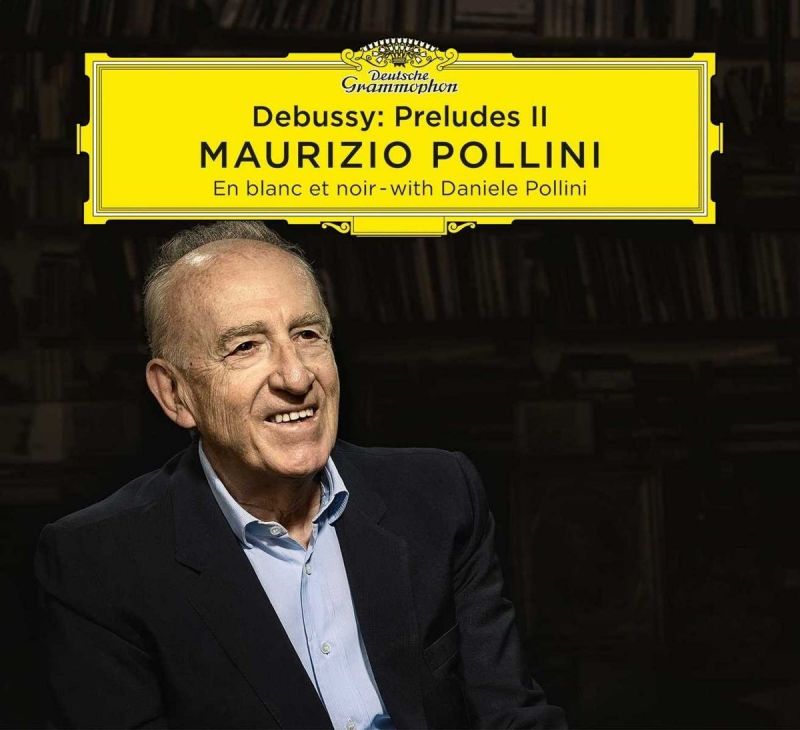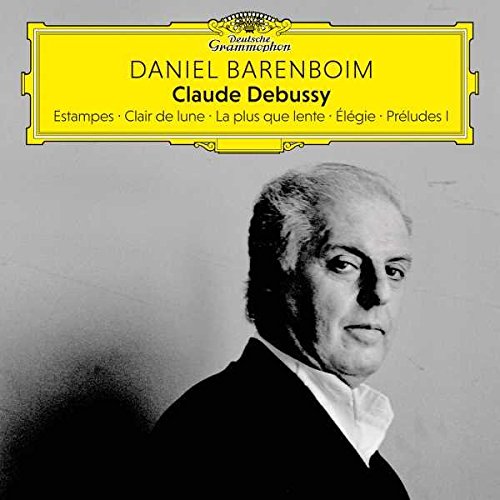DEBUSSY Préludes (Barenboim; Pollini)
View record and artist detailsRecord and Artist Details
Composer or Director: Claude Debussy
Genre:
Instrumental
Label: Deutsche Grammophon
Magazine Review Date: 03/2018
Media Format: CD or Download
Media Runtime: 49
Mastering:
DDD
Catalogue Number: 479 8490

Tracks:
| Composition | Artist Credit |
|---|---|
| (24) Préludes, Movement: Book 2 (Complete) |
Claude Debussy, Composer
Claude Debussy, Composer Maurizio Pollini, Piano |
| En blanc et noir |
Claude Debussy, Composer
Claude Debussy, Composer Daniele Pollini, Piano Maurizio Pollini, Piano |
Composer or Director: Claude Debussy
Genre:
Instrumental
Label: Deutsche Grammophon
Magazine Review Date: 03/2018
Media Format: CD or Download
Media Runtime: 69
Mastering:
DDD
Catalogue Number: 4798 741GH

Tracks:
| Composition | Artist Credit |
|---|---|
| (3) Estampes |
Claude Debussy, Composer
Claude Debussy, Composer Daniel Barenboim, Piano |
| Suite bergamasque |
Claude Debussy, Composer
Claude Debussy, Composer Daniel Barenboim, Piano |
| (La) Plus que lente |
Claude Debussy, Composer
Claude Debussy, Composer Daniel Barenboim, Piano |
| Elégie |
Claude Debussy, Composer
Claude Debussy, Composer Daniel Barenboim, Piano |
| (24) Préludes, Movement: Book 1 (Complete) |
Claude Debussy, Composer
Claude Debussy, Composer Daniel Barenboim, Piano |
Author: Jed Distler
The Préludes begin with a broad yet occasionally sagging ‘Danseuses de Delphes’. Barenboim imbues the static whole-tone harmony of ‘Voiles’ with alluring half-tints, even though he prefers his own tempo shadings to Debussy’s more effective markings (the transitional cédez directives, for example). His clunky fingerwork renders ‘Le vent dans la plaine’ dead on arrival, but No 4 oozes nuance and sensuality. In No 5 Barenboim emphasises the build between bars 6 and 9 with minimum pedal and maximum foot stomping, while uncovering rarely heard lower-register inner voices in the central section.
If Barenboim doesn’t match Steven Osborne’s pinpoint control and scaling of dynamics in No 7 (Hyperion, 10/06), he unquestionably taps into the music’s tumultuous character. No 8’s flaxen-haired girl emerges with a kind of elusive charm via Barenboim’s subtle and effective pedal blurrings. No 9’s interrupted serenade moves more deliberately than usual, yet Barenboim’s crisply articulated repeated notes and sense of lilt are right on the money, as are No 11’s upwards scales and No 12’s gawky cakewalking gruppetti. Even the unorthodoxly slow and muted quasi tambouro passage at the end works. Barenboim’s concentration and sustaining capabilities are best revealed throughout ‘Des pas sur la neige’ and ‘La cathédrale engloutie’. In the latter, incidentally, Barenboim follows the unmarked yet implied tempo changes Debussy made in his 1913 Welte-Mignon piano roll recording.
The ample ambience and close perspective enveloping Barenboim’s piano in Book 1 contrasts with the comparably focused yet relatively distant patina characterising Pollini’s Préludes Book 2, his first Debussy outing since 1999’s Book 1 (1/00). The close-lying alternating chords and scales of ‘Brouillards’ have a clarity and forward impetus similar to Michelangeli’s DG recording, not to mention the rippling sheen of the runs from bar 29 onwards (1'17"). My only quibble concerns Pollini’s insufficiently soft pianissimos. While he doesn’t really evoke Debussy’s Lent et mélancolique indication in ‘Feuilles mortes’, his gorgeous pedalwork and sexy chord-playing enliven a prelude that usually suffers from perfunctory performances. At first, ‘La puerta del vino’ may strike you as overly fast and driven. Listen with score in hand, however, and you’ll notice how Pollini’s careful and inherently musical adherence to Debussy’s markings intensely underscore the composer’s intention to walk that thin line between passion and violence. The left hand’s steady habanera rhythm provides an insistent yet never rigid anchor for the expressive economy of Pollini’s right hand.
However, in ‘Les fées sont d’exquises danseuses’, Pollini falls below form; the leggierissimo passages lack suppleness and the long pianissimo trills are never quiet enough. The calm and lyrical elegance one expects from ‘Bruyères’ is missing from Pollini’s stern, unyielding rendition. But in No 6 the pianist captures General Lavine’s teetering stride to perfection, even pushing ahead in hot anticipation of the sudden fortes. While Pollini makes each of the tempo adjustments audible in Nos 7 and 8, his literalism allows for little breathing-room and fanciful subtext. This approach works better for No 9’s grave ‘God Save the Queen’ opening and the pianist’s staggering controlled dotted double notes. The ‘sad calm’ implicit in the processional chords of ‘Canope’ seems at odds with Pollini’s matter-of-fact phrasing, although there’s always an appreciably dissonant edge to the recurring phrases with repeated C sharps. Pollini’s alternating thirds in No 11 yield to Zimerman, Aimard and Ciani (among his DG label-mates) for control and evenness, although he must have imbibed at the fountain of youth before diving into ‘Feux d’artifice’!
Pollini’s son Daniele joins his father on first piano for En blanc et noir, where the music’s acerbic wit, hair-trigger dynamic contrasts, allusive gestures, fleeting rays of warmth and myriad ensemble traps pose no problems whatsoever. Such flexible, transparent and stylish two-piano-playing augurs well for future father and-son collaborations.
Discover the world's largest classical music catalogue with Presto Music.

Gramophone Digital Club
- Digital Edition
- Digital Archive
- Reviews Database
- Full website access
From £8.75 / month
Subscribe
Gramophone Full Club
- Print Edition
- Digital Edition
- Digital Archive
- Reviews Database
- Full website access
From £11.00 / month
Subscribe
If you are a library, university or other organisation that would be interested in an institutional subscription to Gramophone please click here for further information.




